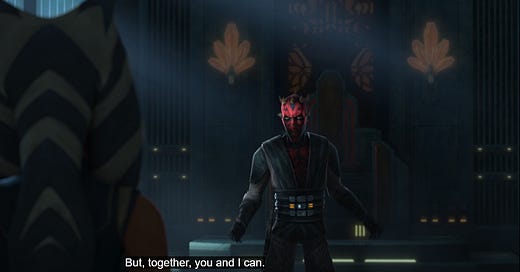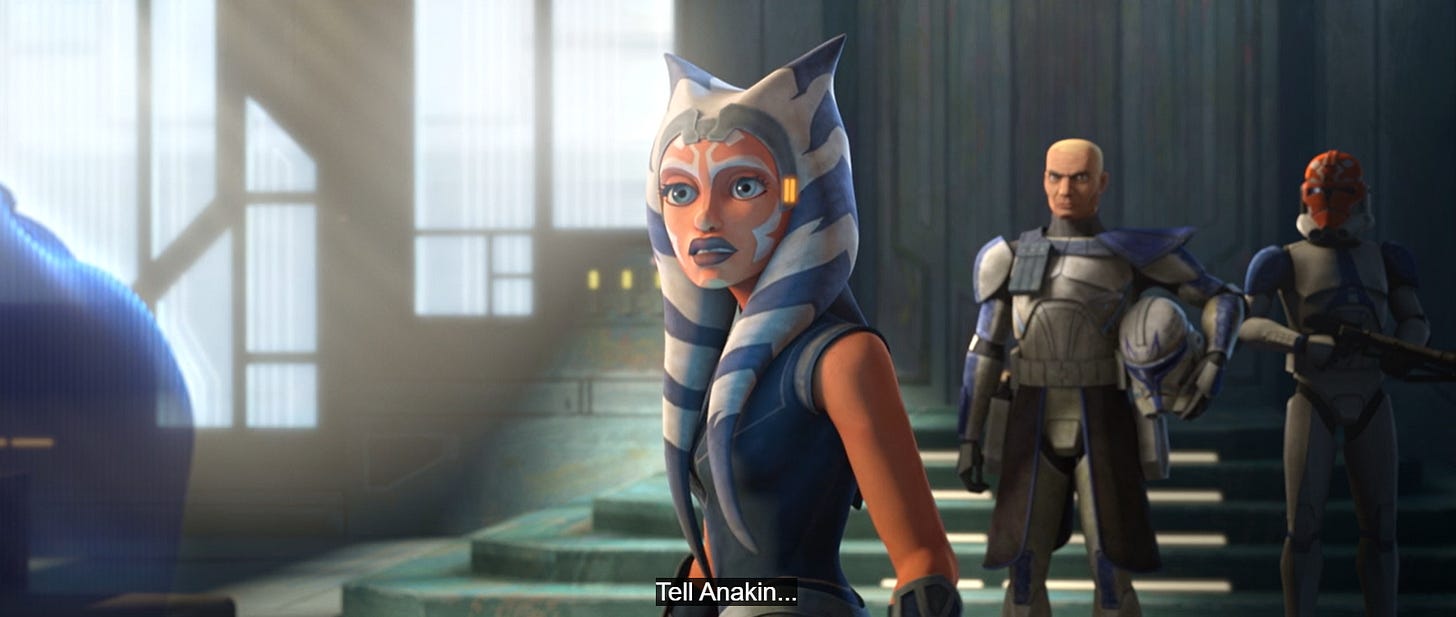As a writer I enjoy plotting. I like the complicated weave of events and characters and choice that makes up great fiction. But one of my pet peeves, and something I am very careful to watch for, is making a story too plot-driven and taking away character agency. I want to talk a little bit about one of my favorite moments in Star Wars that’s also a great example of giving a character agency.
The Clone Wars
The animated Clone Wars series has a lot of haters and a lot of fans, and I put myself in the latter category for the most part. The first two seasons were slow. Dave Filoni and the creative team were still feeling out what they wanted the show to be. But in the third season things started to take off.
I’ll fully admit the show isn’t for everyone, and that’s fine. Tastes are subjective. But there are some amazing moments in the show, and it really serves to flesh out the characters and events between Attack of the Clones and Revenge of the Sith.
In a lot of ways The Clone Wars does a far superior job of characterizing Anakin Skywalker than the movies. Admittedly, it has much more time (almost 56 hours of total run time-but only a fraction of that involves Anakin) to do this and can show him in far more and more varied situations than three feature-length movies.
One of the things I find fascinating about the show is we know how everything ends. We know how Attack of the Clones starts and how Revenge of the Sith goes. Yet the show works. There are diversions and side quests along the way, but it does a great job of keeping interest until the end. And the much-delayed Season 7 which premiered in February of 2020 did a good job of wrapping up plot lines and bringing the main characters right into Revenge of the Sith.
The season is divided up into three arcs. The first introduces a new group of heroes called The Bad Batch, who end up with their own spinoff which just recently began its third and final season.
The second arc deals with Ashoka after she was booted from the Jedi Order. Even though Anakin discovered and exposed the plot to frame Ashoka, she refused to rejoin the order and left to make her own way in the universe.
But what I want to talk about today is the third arc, Episodes 9 through 12.
“Cartoons are for Kids”

Tell that to these four Deathwatch Mandos who just lost their heads. If you’d like to watch the full clip, you can find it here on YouTube.
As the series goes on, it gets progressively more serious. We’re drawn into the web of plots and intrigue surrounding Palpatine: catching glimpses of a power grab here, an assassination there. But no one can put the pieces together.
Mid-way through Season 7 Ashoka is approached by Bo-Katan Kryze of Mandalore who has a piece of information the Jedi will no doubt want: the whereabouts of a certain Darth Maul.
Long story short, Ashoka is dispatched with a small clone army in company with Bo’s Mandalorians to capture Maul on Mandalore, where he has ensconced himself as the ruler of the planet (side note-that’s why making the person with a magic black sword your ruler no questions asked is dumb).
This scene below is one of my favorites. Ashoka, Bo, and their forces have tracked Maul down, trapped his supporters in isolated sections of the city, and are on the edge of victory. Then Maul strikes back, launching a broad attack on the Republic forces, all so he can have a chat with Ashoka.
Ashoka knows Maul. Knows what he is, what he’s done. He’s killed Jedi and been at the center of the mystery around Sidious for longer than she’s been in the order.
Maul offers her a choice. Continue as you are and the galaxy is plunged into darkness. Or help me (Maul), and we can avoid disaster by killing Sidious together.
And the thing is, SHE AGREES. She agrees to help him, a Sith. Everything she has fought against her whole life. Someone who probably has designs to turn her to the Dark Side eventually. This is a serious frakking decision. One that will have massive consequences for her as a (former) Jedi. What will the Jedi think? Even if she’s doing the “right thing” to stave off disaster, she’s working with a Sith. That won’t make her many friends. Either way the galaxy will not be the same.
And she agrees in order to stop Sidious. But then she asks a question about Anakin. Why is Maul so interested in him?
And when Maul tells her the truth, the exact, absolute truth, she rejects it.
And so the last chance to avert disaster is lost. Because of Ashoka’s choice to believe in her friend, her former Master. To believe he could never fall to the Dark Side.
This is character agency at its greatest. If she, right now, reaches out to Anakin to warn him of what’s coming things might turn out different. This scene happens mere hours before Obi-Wan kills Grievous and the Jedi Masters move to arrest Palpatine. With his suspicions about the Chancellor and forewarned of a Sith Lord with designs on a new apprentice, he could have made a different decision.
He could have. But he might not. Because character agency and choice matter. And that decision, whether to join the Dark Side or not, rests solely with Anakin.
Postscript
I know this is somewhat of an academic discussion. Season 7 of The Clone Wars was written in 2019, fourteen years after Revenge of the Sith premiered in theaters. So Ashoka’s actual character agency is minimal (also, none of this is real anyway). But as writers, we plan and plot ahead anyway and figure out ways to get our characters to do things that seem natural for them. And for Ashoka this was an absolutely natural decision.






